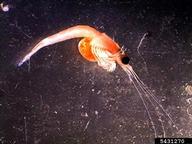Overview
The bloody red shrimp is a mysid, a relative of the native Great Lakes opossum shrimp, Mysis relicta (identified in some recent scientific literature as Mysis diluviana). Both species have stalked eyes and are generally less than 1/2 inch in length. The intensity of coloration varies with contraction or expansion of the chromatophores in response to light and temperature conditions; in shaded areas, individuals tend to have a deeper red color (Ketelaars et al. 1999; Pothoven et al. 2007; Salemaa and Hietalahti 1993). The best way to tell the two species apart is by the shape of the tail (requiring a hand lens or low magnification microscope)–the native Mysis has a deeply forked tail, whereas the new invader has a flat end to its tail with two prominent terminal spines. Identifications should be confirmed by an expert.
The bloody red shrimp prefers habitats associated with hard structures or rocky bottoms and actively avoids direct sunlight. It has a unique swarming behavior unlikely to be confused with anything else in the Great Lakes. During daylight hours, it may be observed forming reddish swarms in the shadows of piers, boats, or breakwalls. Swarms disperse at night, but in clear calm waters, the bloody red shrimp may be detected at night by shining a bright light on the water—the shrimp will rapidly swim away from the light. It is unknown at this point whether zebra and quagga mussel beds in the Great Lakes will be suitable habitat for the shrimp. The species avoids soft bottoms and vegetation. In its native range, across Europe and in the Baltic Sea, the bloody red shrimp is found in water depths to 50 meters (166 feet). It seems to prefer slow moving waters, but has been found along rocky, wave-exposed shorelines. The shrimp is also reported to spend daylight hours hiding in rocky crevasses and boulder cavities, but has also been observed swarming in shadowed areas near the surface by day.
Bloody red shrimp were brought to the Great Lakes via the ballast tanks of ocean-going vessels and first discovered in 2006 in Lake Michigan and Ontario. In February 2018, they were found in Lake Superior.
Table of Contents


Origin & Dispersal

- Learn to identify bloody red shrimp
- Inspect and remove aquatic plants and animals from boat, motor, and trailer
- Drain lake or river water from livewell and bilge before leaving access
- Dispose of unwanted live bait in the trash
- Never dump live fish from one body of water into another
- Report sightings of bloody red shrimp to CAKE CISMA
Bloody red shrimp. Hemimysis anomala.
Capture of mysids in a single sweep using a kick net.
Impacts While long-term impacts on the Great Lakes are not yet known, the bloody red shrimp is considered a high risk invader to inland lakes in the Great Lakes region. |








Reporting Invasive Species – FREE APP The MISIN smartphone app provides a mobile solution for the capture of invasive species field observation data. You can play an important role in the early detection and rapid response to new invasive threats in your area by contributing invasive species observations to the MISIN database.
|



